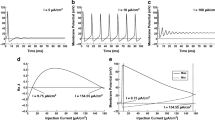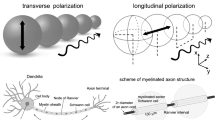Abstract
Our preceding paper presented a relaxation oscillator model generally applicable to the description of the spike generation zone of an afferent nerve fiber. This model was shown to reproduce the measured stimulus-response characteristics of the elasmobranch ampullary electroreceptor. In this paper, our optimized model is shown to resolve input stimulus currents or current shifts as small as 50 fA. The fractional spike generator frequency shift produced by injection of this minimum resolvable current is Δf/f≈2×10−3. Arguments based upon known properties of both glutamatergic postsynaptic membrane channels and the electroreceptor organ suggest that this resolvability substantially exceeds that required to account for the known sensitivity of elasmobranch fish to marine electric fields. Our estimates of synaptic input current noise indicate that it will limit the minimum resolvable fractional change of synaptic input current to the range 10−1–10−2 and will thereby limit the minimum resolvable in vivo spike generator fractional frequency shift to the same range. For our optimized model, increase of the minimum resolvable fractional shift of spike generator frequency into this range can be accomplished by injection of ‘white’ stimulus current noise of ≈ 1 pA rms, over a bandwidth of 4–200 Hz. These results lead to the conclusion that synaptic input current noise, rather than inherent spike generator stability, limits electroreceptive sensitivity in vivo. This noise limit is also consistent with the Weber-Fechner criterion derived from psychophysical studies, which places the minimum resolvable fractional change of input stimulus in this same range. We suggest that synaptic current noise provides the physiological basis for the Weber-Fechner criterion. The model studies of this and the preceding paper indicate that the remarkable electroreceptive sensitivity exhibited by marine elasmobranches can be accounted for within the framework of well-known physical principles, with no requirement of ad hoc assumptions relating to the structure or function of the electroreceptor organ.
Similar content being viewed by others
References
Akoev G, Andrianov GN, Szabo T, Bromm B (1991) Neuropharmacological analysis of synaptic transmission in the Lorenzinian ampulla of the skate Raja clavata. J. Comp Physiol [A] 168:639–646.
Bennett MVL, Obara S (1986) Ionic mechanisms and pharmacology of electroreceptors. In: Bullock TH, Heiligenberg W (eds) Electroreception. Wiley, New York 157–181.
Bruner LJ, Harvey JR (1994) Synaptic current noise limits the ability of sensory transduction to detect a change of input stimulus: the example of electroreception. Biophys J 66(2 Pt 2):A256.
Bruner LJ, Harvey JR (1995) The spike generation zone of the ampullary electroreceptor. I. Stimulus-response characteristics of a relaxation oscillator circuit model. Biol Cybern 72:371–378.
Buckingham MJ (1983) Noise in electronic devices and systems. Wiley, New York.
Clusin WT, Bennett MVL (1977a) Calcium-activated conductance in skate electroreceptors. Current clamp experiments. J Gen Physiol 69:121–143.
Clusin WT, Bennett MVL (1977b) Calcium-activated conductance in skate electroreceptors. Voltage clamp experiments. J Gen Physiol 69:145–182.
Clusin WT, Bennett MVL (1979a) The oscillatory responses of skate electroreceptors to small voltage stimuli. J Gen Physiol 73:685–702.
Clusin WT, Bennett MVL (1979b) The ionic basis of oscillatory responses of skate electroreceptors. J Gen Physiol 73:703–723.
Dilger JP, Brett RS (1990) Direct measurement of the concentrationand time-dependent open probability of the nicotinic acetylcholine receptor channel. Biophys J 57:723–731.
Dudel J, Franke C, Hatt H (1992) Rapid activation and desensitization of transmitter-liganded receptor channels by pulses of agonists. In: Narahashi T (eds) Ion channels. Plenum, New York, pp 207–260.
Geisler CD, Goldberg JM (1966) A stochastic model of the repetitive activity of neurons. Biophys J 6:53–69.
Hille B (1992) Ionic channels of excitable membranes, 2nd edn. Sinauer, Sunderland.
Kalmijn AJ (1974) The detection of electric fields from inanimate and animate sources other than electric organs. In: Handbood of sensory physiology, Vol III/3. Fessard A (ed) Springer, New York, 147–200.
Kalmijn AJ (1982) Electric and magnetic field detection in elasmobranch fishes. Science 218:916–918.
Murray RW (1962) The response of the ampullae of Lorenzini of elasmobranches to electrical stimulation. J Exp Biol 39:119–128.
Murray RW (1965) Electroreceptor mechanisms: the relation of impulse frequency to stimulus strength and responses to pulsed stimuli in the ampullae of Lorenzini of elasmobranches. J Physiol (Lond) 180:592–606.
Murray RW (1974) The ampullae of Lorenzini. In: Fessard A (eds) Handbook of sensory physiology, Vol III/3. Springer, New York, pp 125–146.
Perkel DH, Bullock TH (1967) Neural coding. Neurosci Res Prog Bull 6:221–348.
Stein RB (1965) A theoretical analysis of neuronal variability. Biophys J 5:173–194.
Stein RB (1967) Some models of neuronal variability. Biophys. J 7:37–68.
Uttal WR (1973) The psychobiology of sensory coding. Harper and Row, New York.
Waltman B (1966) Electrical properties and fine structure of the ampullary canals of Lorenzini. Acta Physiol Scand 66 [Suppl 264]:1–60.
Author information
Authors and Affiliations
Rights and permissions
About this article
Cite this article
Harvey, J.R., Bruner, L.J. The spike generation zone of the ampullary electroreceptor. Biol. Cybern. 72, 379–387 (1995). https://doi.org/10.1007/BF00201413
Received:
Accepted:
Issue Date:
DOI: https://doi.org/10.1007/BF00201413




